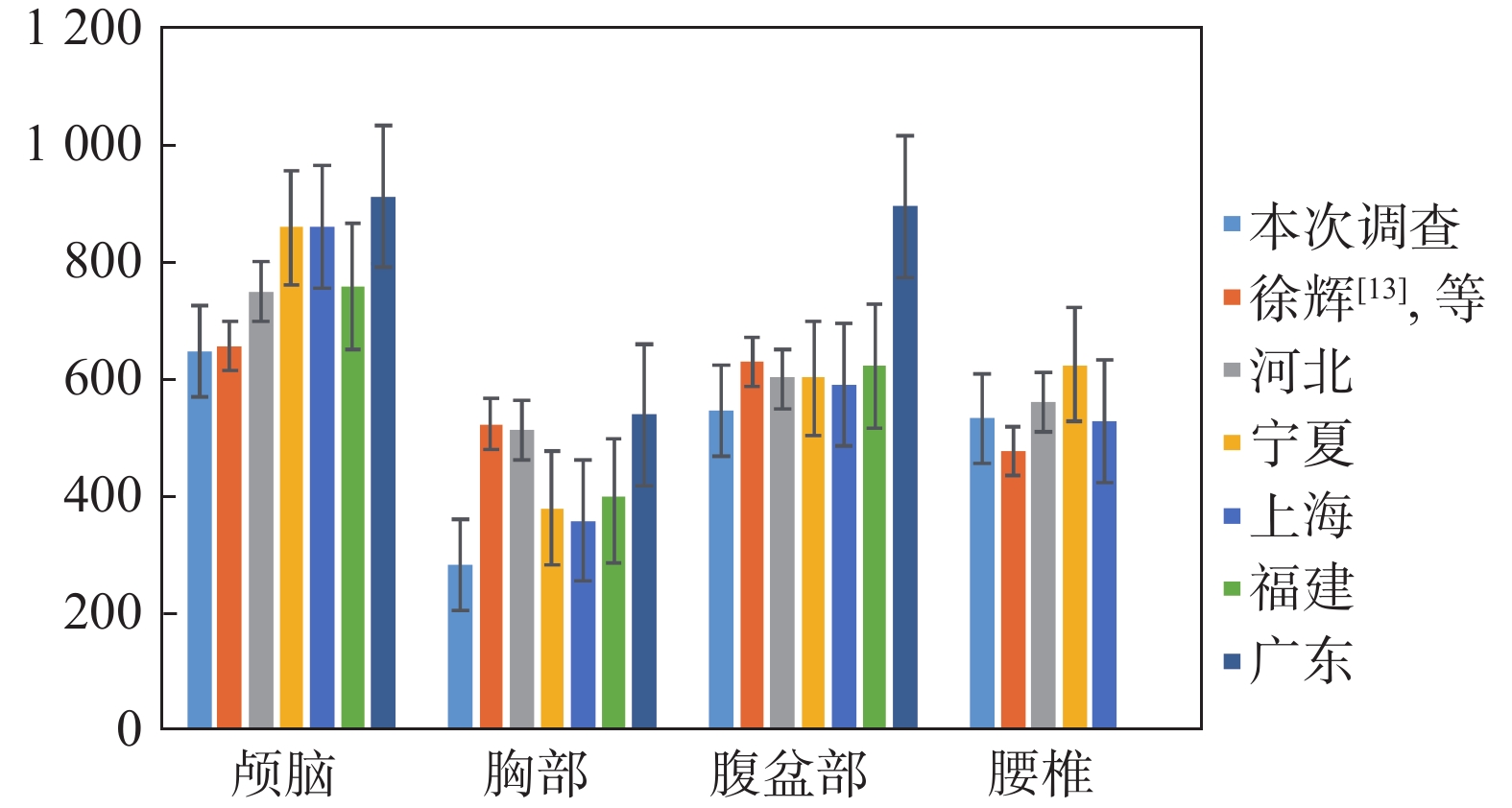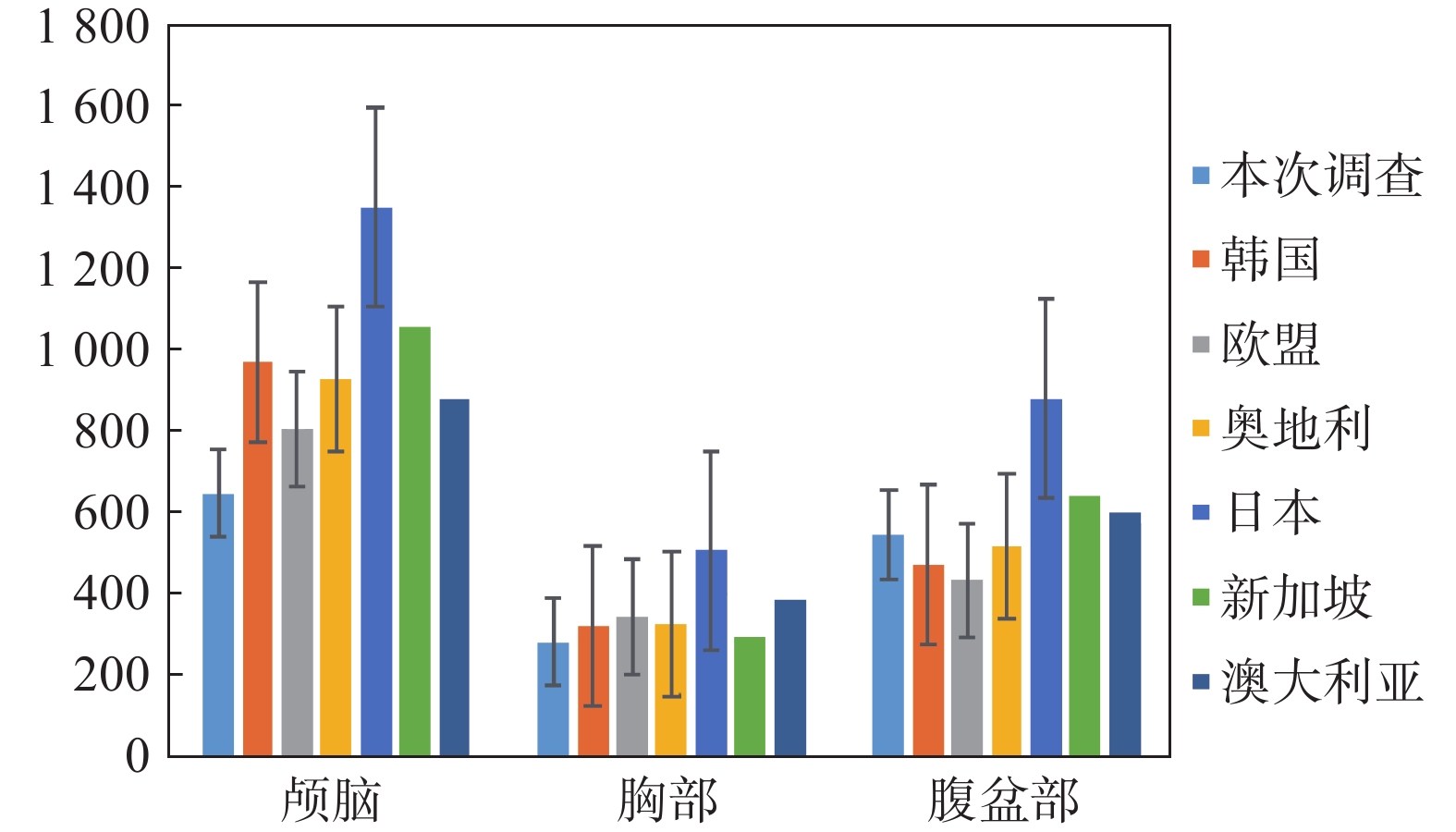2. 青岛市中心医疗集团, 山东 青岛 266042;
3. 青岛市第八人民医院; 山东 青岛 266121;
4. 青岛市市立医院, 山东 青岛 266071
2. Qingdao Central Medical Group, Qingdao 266042 China;
3. Qingdao 8th People’s Hospital, Qingdao 266121 China;
4. Qingdao Municipal Hospital, Qingdao 266071 China
随着X射线计算机断层扫描(computed tomography,CT)设备的普及,CT检查的数量有了迅猛的增长,带来的辐射风险也随之增加。2009—2018年,全球平均医疗照射检查频度574人次/千人口,其中,高收入国家和中等收入国家分别为
选取青岛市3家综合性三级医院和1家一级医院的CT检查数据。根据不同的检查部位,在医学影像存档与通信系统(PACS)中随机抽取病人检查资料。时间范围自2022年1月1日—2022年12月31日。
1.2 调查方法 1.2.1 调查部位由于各家医院在进行CT扫描时,实际情况差异较大。为了便于比较,选取扫描参数和扫描范围比较容易确定的11个部位进行统计,分别为颅脑、鼻窦、颈部、胸部、腹盆部、颈椎、腰椎、颅脑CTA、颈部CTA、肺动脉CTA和主动脉CTA(胸 + 腹)。颈椎和腰椎有逐层扫描和螺旋扫描2种扫描模式。前者在不同医院,甚至同一家医院的不同技师、不同病人间扫描椎间盘的数量差异较大,不利于比较,因此本调查只统计颈椎和腰椎的螺旋扫描模式。主动脉CTA选取全主动脉(胸 + 腹)的数据进行统计。
1.2.2 病人年龄本次调查只统计18岁及以上成人的扫描数据,不包括儿童受检者。
1.2.3 数据类型包括影像号(ID号)、性别、年龄、检查项目(部位)、管电压(kV)、管电流时间积(mAs)、容积CT剂量指数(CTDIvol)、剂量长度乘积(DLP)。其中CTDIvol和DLP记录单一扫描序列的数据,不包括定位像等其他序列。
1.2.4 调查数量每台设备每个部位病例数不少于30例。因各家医院的CT设备使用各有侧重,比如发热门诊CT只做胸部平扫;高档CT设备多用于强化及CTA等,故每台设备能记录的部位种类也有所差异。
1.3 质量控制首先制定数据调查草案,由所有参与人员进行讨论,并初步确定调查部位、数据类型、数据来源,制定调查表格。然后进行初步数据统计。2周后调查小组就调查过程中遇到的问题汇总,并讨论解决方法,形成最终调查方案。调查过程中不定期抽查数据,保证调查标准的统一,对扫描范围过大或不足、伪影严重、重复检查、连续多部位扫描、登记与实际扫描部位不一致等情况予以记录和标记。调查结束后将数据汇总并由专门人员进行审核,将带有上述标记的数据予以排除,符合要求的数据录入Excel表格。
1.4 统计学处理使用SPSS 19.0进行统计分析。按照ICRP推荐的方法[11],对于某一特定部位,先将单台设备的CTDIvol和DLP数据按大小排序,取其中位数;后将所有设备记录的该部位的中位数再次排序,分别计算25%、50%和75%位数。其余部位以此类推。
2 结 果 2.1 设备本次调查共涉及14台CT设备,包括美国通用电气公司(GE)2台、德国西门子股份公司(Siemens)4台、荷兰飞利浦公司(Philips)4台、联影医疗科技股份有限公司3台、东软医疗系统股份有限公司1台。
2.2 CT检查项目的分布本次调查共获得数据
本调查发现,CT检查多采用固定管电压模式,范围110~130 KV。大部分设备具有自动mAs调制技术。部分老旧设备使用固定mAs,大小主要由检查技师确定,见表1。
|
|
表 1 成人常见部位CT检查扫描参数 Table 1 CT scan parameters for different body parts of adults |
|
|
表 2 成人不同部位CT检查剂量 Table 2 CT radiation doses of different body parts of adults |
CT检查受检者辐射剂量见表2。不同检查部位CTDIvol和DLP变化范围较大。CTDIvol颅脑最大(75%位值52.0 mGy),胸部最小(75%位值8.2 mGy)。DLP最大的为颅脑CTA(75%位值657.9 mGy·cm),颈部最小(75%位值228.1 mGy·cm)。
2.5 CT扫描剂量与行业标准和其他地区比较与2018年中国卫生健康委员会发布的《X射线计算机断层摄影成年人诊断参考水平(WS/T 637—2018)》[12]相比,本次调查各部位CTDIvol和DLP的75%位分值均明显偏低。主动脉CTA差别最大,DLP是行业标准的1/3(0.325倍);腰椎差别最小,DLP是行业标准的0.92倍,见表3。
|
|
表 3 成人各部位CT辐射剂量与行业标准比较(75%位值) Table 3 Comparison of CT radiation doses in different body parts of adults in Qingdao with the industry standard (3rd quartile values) |
与国内其他地区和国外数据[13-24]比较见表4和表5及图1和图2。
|
|
表 4 成人各部位CT辐射剂量与国内其他地区比较(75%位值) Table 4 Comparison of CT radiation doses in different body parts of adults in Qingdao with other regions in China (3rd quartile value) |
|
|
表 5 成人各部位CT辐射剂量与国外其他地区比较(75%位值) Table 5 Comparison of CT radiation doses in different body parts of adults in Qingdao with regions in other countries (3rd quartile value) |

|
图 1 成人不同部位DLP与国内部分地区数据比较(75%位值) Figure 1 Comparison of DLP in different body parts of adults in Qingdao with other regions in China (3rd quartile value) |

|
图 2 成人颅脑、胸部及腹部DLP与国外数据比较(75%位值) Figure 2 Comparison of DLP for the head, chest, and abdomen of adults in Qingdao with regions in other countries (3rd quartile value) |
CTDIvol与设备性能和技术参数有关,DLP的大小主要取决于CT的扫描范围,或者说与病人体型有关。通常选取调查数据中典型患者辐射剂量分布的75%位数作为某一地区的诊断参考水平(DRL)[25]。当辐射剂量超过DRL时,应进行回顾性分析和优化,在保证图像质量满足诊断要求的前提下,降低扫描条件,控制辐射剂量。
本次调查显示成人各部位DLP差异较大。75%位值最高的是颅脑CTA,DLP为657.9 mGy·cm,是颈部CT平扫(228.1 mGy·cm)的2.88倍。DLP由高到低依次为颅脑CTA、颅脑平扫、颈部CTA、腹盆部、腰椎(螺旋)、主动脉CTA、肺动脉CTA、鼻窦、胸部、颈椎(螺旋)和颈部。CTDIvol 75%位值颅脑CT平扫最高,为52.0 mGy;主动脉CTA最低,仅为7.8 mGy。与《X射线计算机断层摄影成年人诊断参考水平(WS/T 637—2018)》[12]相比,青岛市成人各部位DLP和CTDIvol均明显偏低。腰椎、鼻窦和颅脑CT平扫降幅较小。颅脑CTA、颈部CTA和主动脉CTA降幅较大,仅分别相当于行业标准50%、50%和25%位值的水平,主动脉CTA的DLP仅为行业标准的1/3。一般而言,多层螺旋CT的辐射剂量与管电压(kV)、管电流时间积(mAs)呈正相关,而与螺距因子和准直器宽度呈负相关[26]。本次调查中各医院在辐射剂量的控制方面低于国家行业标准,可能与设备参数的调整有关,也可能与近年来新设备在剂量控制方面的技术进步有关。对DLP明显偏低的某些部位,图像质量的改善也是下一步需要考虑的内容。
与国内其他地区[13-18]比较,本次调查成人颅脑、胸部、腹部和腰椎的DLP也处于较低水平。广东省颅脑、胸部和腹部的DLP较高,分别为914、541、897 mGy·cm,为本次调查相应部位的1.4倍、1.89倍和1.64倍。就腰椎而言,本次调查DLP与上海市(530 mGy·cm)相当,低于宁夏自治区(626.7 mGy·cm)。
本次调查成人颅脑、胸部、腹盆部CTDIvol与韩国[19]、欧盟[20]、新加坡[23]和澳大利亚[24]的数据相当。但颅脑DLP明显低于上述地区。胸部DLP与新加坡相当。腹盆部DLP高于韩国、欧盟、奥地利,低于新加坡和澳大利亚。日本[22]在颅脑、胸部和腹部的CTDIvol和DLP方面均明显高于本次调查数据。
肺动脉栓塞好发于中老年人,也是医院胸痛中心需要重点排查的一种疾病。本次调查中,肺动脉CTA CTDIvol(11.6 mGy)和DLP(433.9 mGy·cm)均高于欧盟数据(9 mGy,307 mGy·cm)[20],说明该检查项目辐射剂量尚有改善空间。
本次调查中对多部位联扫、超范围扫描、不规范多次扫描的数据均不予采用,只用规范扫描产生的数据。而这也可能是本次调查所得数据整体偏低的原因之一。
| [1] |
United Nations. Report of the United Nations scientific committee on the effects of atomic radiation: sixty-seventh and sixty-eighth sessions[R]. New York: United Nations, 2021.
|
| [2] |
姚杰, 高林锋, 钱爱君, 等. 上海市医用X射线诊断应用频度调查[J]. 中华放射医学与防护杂志, 2019, 39(5): 370-375. Yao J, Gao LF, Qian AJ, et al. Survey on frequency of medical X-ray diagnosis in Shanghai[J]. Chin J Radiol Med Prot, 2019, 39(5): 370-375. DOI:10.3760/cma.j.issn.0254-5098.2019.05.009 |
| [3] |
杨云福, 李炜, 张华东, 等. 重庆市医疗卫生机构放射诊疗频度调查分析[J]. 中国辐射卫生, 2021, 30(6): 682-686,692. Yang YF, Li W, Zhang HD, et al. Investigation and analysis of frequency of radiation diagnosis and treatment in medical and health institutions in Chongqing[J]. Chin J Radiol Health, 2021, 30(6): 682-686,692. DOI:10.13491/j.issn.1004-714X.2021.06.005 |
| [4] |
牛振, 刘春旭, 刘彦, 等. 天津市X射线诊断设备医疗照射频度调查[J]. 中华放射医学与防护杂志, 2019, 39(6): 450-453. Niu Z, Liu CX, Liu Y, et al. Investigation on the frequency of medical exposure of X-ray diagnostic equipment in Tianjin[J]. Chin J Radiol Med Prot, 2019, 39(6): 450-453. DOI:10.3760/cma.j.issn.0254-5098.2019.06.009 |
| [5] |
扬声, 闫庆倩, 张菁, 等. 南京市放射诊断机构X射线设备及诊断频度调查[J]. 中华放射医学与防护杂志, 2021, 41(12): 941-945. Yang S, Yan QQ, Zhang J, et al. Investigation of X-ray equipment and radiodiagnostic frequency in Nanjing[J]. Chin J Radiol Med Prot, 2021, 41(12): 941-945. DOI:10.3760/cma.j.issn.0254-5098.2021.12.011 |
| [6] |
张燕, 郑琪珊, 黄丽华, 等. 福建省医用X射线诊断应用频度调查[J]. 中华放射医学与防护杂志, 2019, 39(5): 376-380. Zhang Y, Zheng QS, Huang LH, et al. Survey of diagnostic medical X-ray frequency in Fujian province[J]. Chin J Radiol Med Prot, 2019, 39(5): 376-380. DOI:10.3760/cma.j.issn.0254-5098.2019.05.010 |
| [7] |
张京战, 沈爱国, 高艳辉, 等. 河北省医疗照射应用频度调查[J]. 中华放射医学与防护杂志, 2019, 39(5): 331-337. Zhang JZ, Shen AG, Gao YH, et al. Survey on frequency of medical exposure in Hebei province[J]. Chin J Radiol Med Prot, 2019, 39(5): 331-337. DOI:10.3760/cma.j.issn.0254-5098.2019.05.003 |
| [8] |
赵宇, 张毅, 王瑞翀, 等. 黑龙江省医用X射线诊断应用频度调查[J]. 中华放射医学与防护杂志, 2019, 39(5): 338-343. Zhao Y, Zhang Y, Wang RC, et al. Survey on frequency of medical X-ray diagnosis in Heilongjiang province[J]. Chin J Radiol Med Prot, 2019, 39(5): 338-343. DOI:10.3760/cma.j.issn.0254-5098.2019.05.004 |
| [9] |
霍彬彬, 徐志勇, 陈晓敏. 淮安市2020年放射诊疗资源应用现状调查[J]. 中华放射医学与防护杂志, 2021, 41(7): 509-513. Huo BB, Xu ZY, Chen XM. Current status of the application of radiodiagnosis and radiotherapy resources in Huai’an City in 2020[J]. Chin J Radiol Med Prot, 2021, 41(7): 509-513. DOI:10.3760/cma.j.issn.0254-5098.2021.07.006 |
| [10] |
张秀云, 刘洁, 刘珍友, 等. 青岛市医疗机构X射线诊断设备及检查频率调查[J]. 辐射防护, 2022, 42(6): 630-636. Zhang XY, Liu J, Liu ZY, et al. Investigation on X-ray diagnostic equipment and examination frequency of medical institutions in Qingdao city[J]. Radiat Prot, 2022, 42(6): 630-636. DOI:10.3969/j.issn.1000-8187.2022.6.fsfh202206021 |
| [11] |
Vañó E, Miller DL, Martin CJ, et al. ICRP publication 135: Diagnostic reference levels in medical imaging[J]. Ann ICRP, 2017, 46(1): 1-144. DOI:10.1177/0146645317717209 |
| [12] |
中华人民共和国国家卫生健康委员会. WS/T 637—2018 X射线计算机断层摄影成年人诊断参考水平[S]. 北京: 中国标准出版社, 2018. National Health Commission of the People’s Republic of China. WS/T 637—2018 Diagnostic reference levels for adults in X-ray computed tomography[S]. Beijing: Standards Press of China, 2018. (in Chinese) |
| [13] |
徐辉, 岳保荣, 尉可道, 等. 我国CT扫描检查中受检者剂量调查结果与分析[J]. 中华放射医学与防护杂志, 2019, 39(3): 213-217. Xu H, Yue BR, Wei KD, et al. Investigation and analysis on the dose of the subjects in CT scanning in China[J]. Chin J Radiol Med Prot, 2019, 39(3): 213-217. DOI:10.3760/cma.j.issn.0254-5098.2019.03.010 |
| [14] |
郭大伟, 罗英男, 高艳辉, 等. 河北省CT检查成年受检者剂量水平调查[J]. 职业与健康, 2021, 37(7): 865-868. Guo DW, Luo YN, Gao YH, et al. Investigation on dose level of adult subjects undergoing CT examination in Hebei Province[J]. Occup Health, 2021, 37(7): 865-868. DOI:10.13329/j.cnki.zyyjk.2021.0217 |
| [15] |
邱海静, 高知玲, 贾晶, 等. 宁夏成年人常见CT检查项目的辐射剂量状况调查研究[J]. 中华放射医学与防护杂志, 2019, 39(9): 691-696. Qiu HJ, Gao ZY, Jia J, et al. Investigation of radiation dose in CT scanning for adult patients in Ningxia[J]. Chin J Radiol Med Prot, 2019, 39(9): 691-696. DOI:10.3760/cma.j.issn.0254-5098.2019.09.010 |
| [16] |
钱爱君, 高林峰, 姚杰, 等. 上海地区CT扫描检查成年人受检者剂量分析[J]. 中国辐射卫生, 2022, 31(5): 587-591. Qian AJ, Gao LF, Yao J, et al. An investigation of radiation dose to adult subjects in computed tomo-graphy scanning in Shanghai, China[J]. Chin J Radiol Health, 2022, 31(5): 587-591. DOI:10.13491/j.issn.1004-714X.2022.05.012 |
| [17] |
郑森兴, 张燕, 黄丽华, 等. 2016年度福建省医用X射线CT应用频度与剂量调查分析[J]. 中国辐射卫生, 2018, 27(6): 543-546,561. Zheng SX, Zhang Y, Huang LH, et al. Investigation and analysis of the application frequency of medical X-CT and the dose in Fujian Province in 2016[J]. Chin J Radiol Health, 2018, 27(6): 543-546,561. DOI:10.13491/j.issn.1004-714x.2018.06.007 |
| [18] |
谭展, 邹剑明, 黄伟旭, 等. 广东省MDCT机所致受检者剂量水平初探[J]. 中国辐射卫生, 2018, 27(5): 465-467,471. Tan Z, Zou JM, Huang WX, et al. A perliminary study on the radiation dose levels due to MDCT examination in Guangdong Province[J]. Chin J Radiol Health, 2018, 27(5): 465-467,471. DOI:10.13491/j.issn.1004-714X.2018.05.012 |
| [19] |
Nam S, Park H, Kwon S, et al. Updated national diagnostic reference levels and achievable doses for CT protocols: a national survey of Korean hospitals[J]. Tomography, 2022, 8(5): 2450-2459. DOI:10.3390/tomography8050203 |
| [20] |
Tsapaki V, Damilakis J, Paulo G, et al. CT diagnostic reference levels based on clinical indications: results of a large-scale European survey[J]. Eur Radiol, 2021, 31(7): 4459-4469. DOI:10.1007/s00330-020-07652-5 |
| [21] |
Wachabauer D, Röthlin F, Moshammer HM, et al. Diagnostic Reference Levels for computed tomography in Austria: a 2018 nationwide survey on adult patients[J]. Eur J Radiol, 2020, 125: 108863. DOI:10.1016/j.ejrad.2020.108863 |
| [22] |
Kanda R, Akahane M, Koba Y, et al. Developing diagnostic reference levels in Japan[J]. Jpn J Radiol, 2021, 39(4): 307-314. DOI:10.1007/s11604-020-01066-5 |
| [23] |
Liang CR, Chen PXH, Kapur J, et al. Establishment of institutional diagnostic reference level for computed tomography with automated dose-tracking software[J]. J Med Radiat Sci, 2017, 64(2): 82-89. DOI:10.1002/jmrs.210 |
| [24] |
Lee KL, Beveridge T, Sanagou M, et al. Updated Australian diagnostic reference levels for adult CT[J]. J Med Radiat Sci, 2020, 67(1): 5-15. DOI:10.1002/jmrs.372 |
| [25] |
牛延涛, 张永县, 康天良, 等. 成年人CT扫描中辐射剂量和诊断参考水平的探讨[J]. 中华放射医学与防护杂志, 2016, 36(11): 862-867. Niu YT, Zhang YX, Kang TL, et al. Investigation of radiation dose and diagnostic reference levels in CT scanning for adult patients[J]. Chin J Radiol Med Prot, 2016, 36(11): 862-867. DOI:10.3760/cma.j.issn.0254-5098.2016.11.013 |
| [26] |
蔡元文, 覃东进, 文超. 多层螺旋CT扫描所致辐射剂量的主要影响因素分析[J]. 中国医学工程, 2014, 22(1): 9, 11. Cai YW, Qin DJ, Wen C. The major influencing factors of the radiation dose caused by multislice spiral CT scan[J]. China Med Eng, 2014, 22(1): 9, 11. (in Chinese) |




